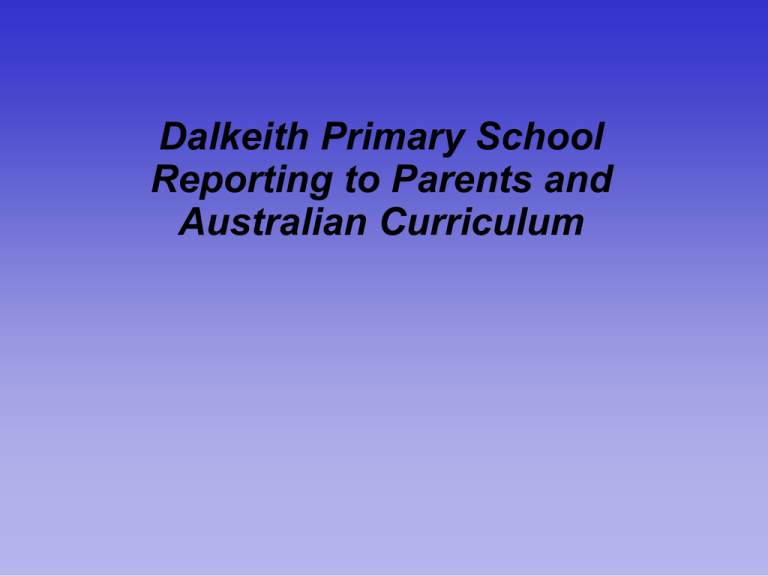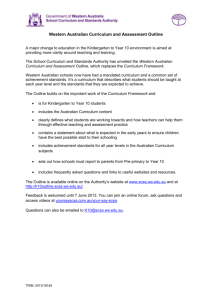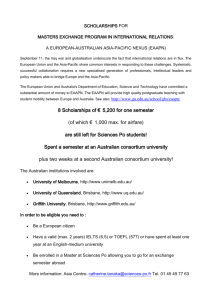Parent information on the CAR policy
advertisement

Dalkeith Primary School Reporting to Parents and Australian Curriculum Education Department's Current Approach CAR Policy 2010 • • • • • Simplified, with a focus on assessment aspects Curriculum Framework Increased flexibility A-E grades remain Student Outcome Statements and levels no longer used: judgements are made against expected standards • A balanced curriculum is guided by the Melbourne Declaration Australian Curriculum Key Information Single, world-class curriculum for all Australians: • from kindergarten (Pre Primary in WA) to Year 12; • Available from 2011 English, mathematics, the sciences and history • then, languages, geography and the Arts; and • a continuum of learning in literacy and numeracy skills • followed by HPE, technologies and the ‘remainder of the humanities’ – economics, business education, civics and citizenship. Australian Curriculum Background In 2008, MCEECDYA ratified the Melbourne Declaration on Educational Goals for Young Australians. The Melbourne Declaration provides all Australian education systems and sectors with a blueprint for progressing education. A key aspect of the agreement was to develop a nationally consistent curriculum across all learning areas, for all students, K-12. The Australian Curriculum, Assessment and Reporting Authority (ACARA) is responsible for development of all materials. Australian Curriculum Website www.acara.edu.au Enter here to register and to view the draft National Curriculum Changes through Australian Curriculum ENGLISH Curriculum Framework National Curriculum National Curriculum Reading Language, Literature, Literacy Reading / Viewing Writing Listening and Speaking Viewing Writing Listening and Speaking Changes through Australian Curriculum MATHEMATICS Curriculum Framework National Curriculum Number Number and algebra Algebra Chance and data Statistics and probability Measurement Measurement and geometry Space Working mathematically Four proficiency strands: understanding, fluency, problem solving and reasoning Appreciating mathematics No direct equivalent Changes through Australian Curriculum SCIENCE Curriculum Framework National Curriculum Investigating Science Inquiry Skills Earth and Beyond Science Understanding Energy and Change Life and Living Natural and Processed Materials Working Scientifically cluster – – – – Communicating Scientifically Science in Daily Life Acting Responsibly Science in Society Science as a Human Endeavour Changes through Australian Curriculum HISTORY Curriculum Framework ( S&E) National Curriculum ( History) Investigation, Communication, Participation Historical Skills Place and Space Some alignment with these outcomes also Resources Culture Time, Continuity and Change Natural and Social Systems Active Citizenship Historical Knowledge and Understandings Australian Curriculum General Capabilities to replace the 13 overarching outcomes of the Curriculum Framework Literacy Numeracy Information and communications technology (ICT) Thinking skills Creativity Self-management Teamwork Intercultural understanding Ethical behaviour Social competence Australian Curriculum Cross-curricular dimensions woven throughout curriculum Indigenous Asia Sustainability Australian Curriculum Reporting Framework A consistent nomenclature to describe the quality of achievement associated with A–E. Generic across year levels and learning areas. Achievement standard will be aligned with a C level. A - D level on the reporting framework describes a quality of learning that is adequate for progression but may indicate the student will need additional support or assistance in progressing within the next level (typically a child on an IEP/GEP) Australian Curriculum Other information The ACARA website contains detailed information on all aspects of the Australian Curriculum (www.acara.edu.au) In addition to draft materials, bulletins and publications, the website also contains answers to a comprehensive range of frequently asked questions. Australian Curriculum Key implementation considerations K(PP)-12. Cross-sectoral. A curriculum for all students. Practical resources. Dalkeith Primary School’s CAR Policy 2010 We reviewed the new Curriculum, Assessment and Reporting (CAR) policy and contextualised it to DPS. CAR policy was ratified by the School Council in June 2010. We developed guidelines for all staff to follow, ensuring we; 1. provide a balanced curriculum 2. regularly monitor, evaluate and report on each student’s achievement. Dalkeith Primary School’s CAR Policy 2010 How we provide a balanced curriculum 1.1 Opportunity to Learn – Learning experiences enable students to observe and practise the actual processes, products, skills and values which are expected of them 1.2 Connection and Challenge – Learning experiences connect with student’s existing knowledge, skills and values while extending and challenging their current ways of thinking. 1.3 Action and Reflection – Learning experiences are meaningful and encourage both action and reflection on the part of the learner. 1.4 Motivation and Purpose – Learning experiences are motivating and the purpose is clear to the students. 1.5 Inclusivity and Difference – Anecdotal and assessment data is analysed to develop learning experiences that respect and accommodate differences between learners. 1.6 Independence and Collaboration – Learning experiences encourage students to learn independently, from others and with others. 1.7 Supportive Environment – The school and classroom setting is safe and conducive to effective learning. Dalkeith Primary School’s CAR Policy 2010 How we regularly monitor, evaluate and report on student achievement 2.1 Provide Students with feedback on their performance 2.2 Use the Department of Education’s reporting templates to issue a report to parents for each student year 1-7 at the end of each semester and Conduct parent teacher interviews end of semester one Issue a student positioning report upon request Teachers follow Dalkeith PS teaching and reporting schedule NAPLAN reports issued to parents in a timely manner MSE reports issued to parents in a timely manner UNSW certificates presented at assembly How we regularly monitor, evaluate and report on student achievement 2.3 Make judgements of student achievement in relation to expected standards Develop and use common Assessment Tasks Use assessment rubrics – teachers and students Familiarise with features of online ‘Exemplars’ Data analysis (MSE, NAPLAN, EARS, SAIS, FIRST CUT, UNSW) Moderation across like year levels and in teams Cross school moderation Whole School Spelling program – SA test Pre-Primary and Kindy work samples and reports Literacy and Numeracy Net PP-3 PIPS testing Pre-Primary terms 1 & 4 Online Interviews term 1 Pre-Primary How we regularly monitor, evaluate and report on student achievement 2.4 Use student performance information to plan future learning programs 2.5 Administer prescribed system assessments 2.6 Engage in ongoing communication with parents about student achievement and progress Semester One Reporting Template Grade Descriptors for Semester One Reports A Excellent The student demonstrates achievement that has greatly exceeded the expected standard. Their achievement is well beyond what is expected at this year level. B Good The student demonstrates achievement that exceeds the expected standard. C Satisfactory The student demonstrates achievement at the expected standard. The student is able to progress to the next level of learning. D Limited The student demonstrates achievement below the expected standard. The student demonstrates a quality of learning that is adequate for progression but will still need additional support or assistance to progress. E Very Low The student demonstrates achievement below the minimum acceptable for this year level. Reporting to Parent Semester One Points to note ‘C’ grade is the expected standard Grade allocations are based on the end of year When determining a grade at the end of semester one, teachers take into account progress already made. This is a major difference from previous grade allocation systems, where there was a sliding scale between semester one and two. Progress can be made within a grade between semester one and two







